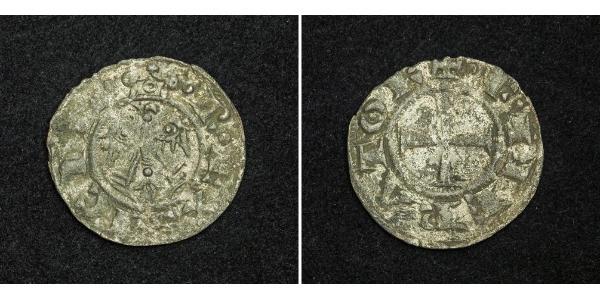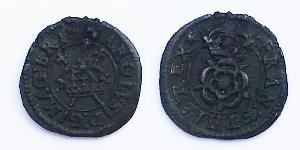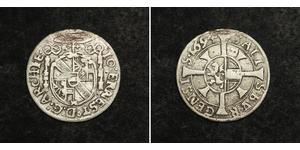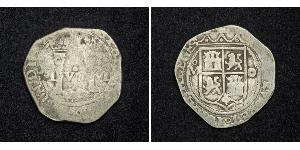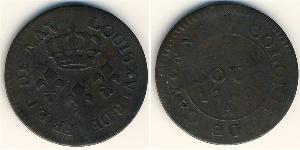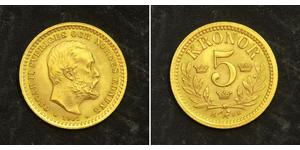(sold for $20.0)
1242, Kindom of Sicily, Frederick II Hohenstaufen. Billon Silver Denaro Coin. F+
Condition: F+
Mint place: Brindisi
Mint year: Struck ca. 1242
Reference: Biaggi 444/445. R!
Denomination: Billon Silver Denaro
Material: Billon (low grade silver)
Diameter: 19mm
Weight: 0.65gm
Obverse: Eagle with crown in legend above.
Legend: REX SICIL
Reverse: Cross pattée within inner circle.
Legend: + F IMPERATOR
The House of Hohenstaufen (or the Staufer(s)) was a dynasty of Germanic Kings (1138-1254), many of whom were also crowned Holy Roman Emperor and Dukes of Swabia. In 1194 the Hohenstaufen became also Kings of Sicily. The proper name, taken from their castle in Swabia, is Staufen. Therefore the dynasty is sometimes also called Swabian dynasty after the family's origin. The dynasty is named after Hohenstaufen Castle, which is located on a mountain of the same name near Göppingen. The castle was built by the first known member of the dynasty, Frederick I, Duke of Swabia.
Frederick II (December 26, 1194 – December 13, 1250), of the Hohenstaufen dynasty, was a pretender to the title of King of the Romans from 1212 and unopposed holder of that monarchy from 1215. As such, he was King of Germany, of Italy, and of Burgundy. He was also King of Sicily from his mother inheritace. He was Holy Roman Emperor (Emperor of the Romans) from his papal coronation in 1220 until his death. His original title was King of Sicily, which he held as Frederick I from 1198 to his death. His other royal titles, accrued for a brief period of his life, were King of Cyprus and Jerusalem by virtue of marriage and his connection with the Crusades.
1194–1250, Holy Roman emperor (1220–50) and German king (1212–20), king of Sicily (1197–1250), and king of Jerusalem (1229–50), son of Holy Roman Emperor Henry VI and of Constance, heiress of Sicily.
In 1196, Henry VI secured the election as German king, or emperor-elect, for his infant son Frederick. When Henry died (1197), his brother, Philip of Swabia, was unable to hold the German magnates to this election, but in Sicily Constance secured Frederick’s investiture as king from Pope Innocent III. Prior to her death (1198) Constance named the pope as Frederick’s guardian; as a child, however, he passed from one Sicilian faction to another.
Meanwhile, in Germany, Otto of Brunswick (Otto IV) and Philip of Swabia were elected rival kings. Otto finally prevailed and was crowned emperor (1209) at Rome, but immediately alienated the pope by attempting to reassert imperial control in Italy. His invasion of Apulia (1210) led Innocent to promote Frederick’s coronation (1212) at Mainz as German king, even though this meant putting a Hohenstaufen on the imperial throne. After Otto’s defeat at Bouvines (1214) by Frederick’s French ally King Philip II, Frederick was recrowned (1215) at Aachen and took the Cross (i.e., pledged to lead a Crusade).
Despite his promises to Pope Innocent III that when crowned Holy Roman emperor he would separate Sicily from the empire by establishing a regency there for his infant son Henry, he reversed these arrangements in 1220. Promising Pope Honorius III to start on his crusade, he secured Henry’s election as German king, and thus his position as imperial successor, shortly before his own imperial coronation (1220) at Rome. This action seemed to insure the union of Sicily and the empire. Under Frederick, however, no such union was effected; Henry governed, first under a regency, in Germany, and Frederick governed Italy and Sicily, which became the seat of his empire.
After his coronation Frederick returned to Sicily. While in Germany, the success of Frederick’s early rule (1212–20) was due largely to his lavishness with imperial lands and rights. In his Sicilian kingdom, which included S Italy, he pursued the reverse of his German policy; he suppressed the barons, transported the Saracens to a colony on the mainland, recovered alienated lands, and began his legislative reforms. In 1224 he founded the university at Naples.
Having married (1225) Yolande, daughter of John of Brienne, he claimed the crown of Jerusalem, but again postponed his departure on crusade. He further offended the pope by reasserting at the Diet of Cremona (1226) the imperial claim to Lombardy. The Lombard League was immediately revived, but open conflict did not break out until 1236. On the insistent demand of the new pope, Gregory IX, Frederick embarked on a crusade (Sept., 1227), but fell ill, turned back, and was excommunicated.
In 1228 he finally embarked. His “crusade,” actually a state visit, was a diplomatic victory. At Jaffa he made a treaty by which Jerusalem, Nazareth, and Bethlehem were surrendered to the Christians, with the Mosque of Omar being left to the Muslims. In 1229 he crowned himself king at Jerusalem. The pope denounced the treaty by Frederick, who was still under excommunication, and sent a papal army to invade Frederick’s kingdom. Frederick returned in 1229 and signed (1230) the Treaty of San Germano, by which he was temporarily reconciled with the pope.
He then turned to strengthening his Sicilian domains in preparation for the inevitable conflict with the Lombard League. Among his achievements in Sicily were his Liber Augustalis (1231), a new body of laws that were the most constructive of the era. In Germany, Frederick attempted to insure support for his Italian policy by granting the princes practically absolute authority within their territories. This policy led to a conflict with his son Henry, who objected to Frederick’s virtual renunciation of his imperial rights in Germany. In 1234 Henry rebelled with the aid of the German towns, but Frederick easily deposed and imprisoned (1235) his son. At the Diet of Mainz (1235), Frederick issued a land peace establishing an imperial court of justice to try all cases except those involving the great vassals. This land peace is one of the monuments of imperial legislation.
In 1236 Frederick began a successful campaign against the Lombard cities, but in Mar., 1239, Pope Gregory IX joined the Lombards and excommunicated the emperor. Frederick issued a circular against the pope and seized most of the Papal States; in May, 1241, he captured a number of prelates en route from Genoa to a general council in Rome, and he was threatening Rome when Gregory died. While emperor and pope were thus at swords’ points, Europe was threatened (1241) by a Mongol invasion under Batu Khan. The Mongols withdrew in 1242.
After the election (1243) of Pope Innocent IV, Frederick offered sweeping concessions to the pope and his allies, but the pope fled (1244) to Lyons, deposed Frederick at the Council of Lyons (1245), and gave the emperor’s foes the privileges of Crusaders. The election (1246) of an antiking to Conrad IV, Frederick’s younger son, plunged Germany into civil war. The war in Italy turned in Frederick’s favor in 1250, but in December he died of dysentery.
Only 1$ shipping for each additional coin purchased!

|
Posted by:
anonymous 2014-03-10 |
5 Krone Sweden Gold Oscar II of Sweden (1829-1907)
group has 9 coins / 8 prices
⇑

